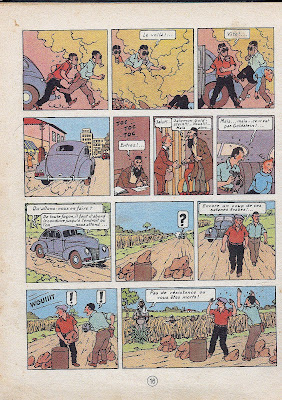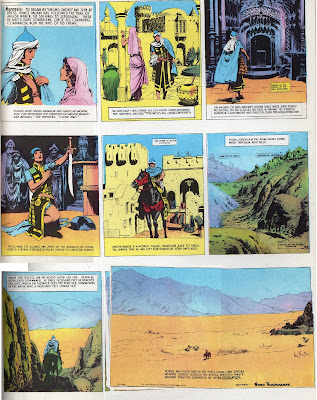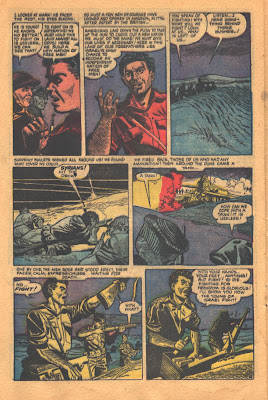While I can't hope to be comprehensive or exhaustive in a 40-minute presentation, I will try to provide answers to such questions as "who?", "what?" "where?" & "when", with respect to what I feel are the most interesting comics that have depicted Israel & Israelis during the 75-year history of the modern comic book.
Before I do so, though, I think it's important to ask the 5th "W" question : "WHY?". Specifically, why should any of us librarians even be interested in looking at this format when no more than 10% of your library patrons - whether you're representing a public, school, synagogue, or university library - even walk into a comic book store at least once a year.
Rather than answer that question, I'll deem it as irrelevant. Comic stories are no longer restricted to the ghettoes of the funny pages in newspapers and comic books found in comic shops. They're also found in graphic novels on bookstore shelves, on countless websites and in popular magazines.
Below is the 2nd page of "Hebron : A Look Inside" by comic journalist Joe Sacco. This appeared in Time Magazine 6 years ago (Mar. 12, 2001).
This is page 1 of "The Underground War in Gaza", also by Sacco, which appeared in The New York Times Magazine just 4 years ago (July 3, 2003). The article is still on the New York Times website and was found on the website of SRI International.
Generally speaking, Sacco tends to portray Israelis (and, in particular, Israeli politicians and soldiers) as cruel, manipulative, sadist outsiders who are oppressing the indigenous, caring, freedom-fighter Palestinians.
I'll come back to Sacco later, but in the interest of full disclosure, I should mention that one of the reasons I'm not one of his biggest fans is a piece he did which ridiculed librarians and patrons alike called "Voyage to the End of the Library" (Yahoo #3, April 1990), reprinted in Alternative Library Literature 1992/1993 : a biennial anthology Jefferson, NC: McFarland & Co., p. 30-38 and Notes from a Defeatist Fantagraphics Books, 2003, p. 109-118).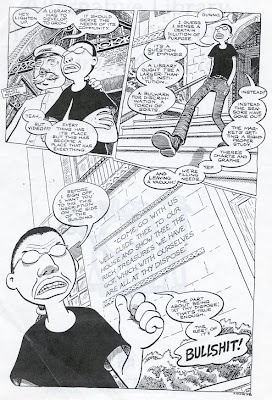
Buy Notes from a Defeatist
Google Search
Goodreads Israel Comix Bookshelf
Saturday, April 26, 2008
Introduction
Sunday, April 20, 2008
1930s
On the left is the original page 15 of Tintin au Pays de l'Or Noir, written & illustrated in Belgium by Hergé (Georges Prosper Remi), serialized in Le Petit Vingtième (September 28, 1939 - May 8, 1940 / September 16, 1948 - February 23, 1950) and then published as a an album by Casterman in 1950 - just 2 years after the UN partition vote.
The delay between May 1940 and Sept. 1948 was due to the Nazi occupation of Belgium. Hergé and his editors thought it wouldn't be prudent to continue a story which involved a German villain while the Nazis controlled the Belgian press.
On the right is the version redrawn in 1972 for the Methuen (British) translated edition. Methuen decided that references to British mandate Palestine were far out of date and a fictional Arab country was used for the setting instead.
Sunday, April 13, 2008
1940s
Among the earliest depictions of Israel in comix are the retellings of Biblical stories, particularly those which ocurred after the Jews entered into the Holy Land (i.e. from the book of Prophets onward). Numerous Biblical comics have been published since the 1940's, which puts them into a separate category of its own. Therefore, I will limit the scans for such adaptations to the one below, which is the cover of Picture Stories from the Bible #4 (Fall 1943), depicting the prophet Elijah.
Buy Picture Stories from the Bible : Old Testament
During the 1940's Hal Foster wrote & elegantly illustrated a Sundays-only color comic strip about an Arthurian-age knight named Val. In a storyline in which Val travels to the Middle East to get back his special "singing sword", Val ends up in the Israel of the Middle Ages twice, passing by or entering such famous sites as the Jaffa Gate, the Tower of David and the Church of the Holy Sepulchre. Though he doesn't seem to encounter any Jews during this pilgrimage, he does help fend off a group of Saracens (i.e. Muslims) who are attacking a fellow knight. This occurs in the strips published on May 25th & June 1st in 1941, reprinted in Prince Valiant : Companions in Adventure (Nostalgia Press, 1974) and Oct. 12th & Oct. 19th in 1941, reprinted in Prince Valiant : The Love of Aleta (Nostalgia Press, 1974).

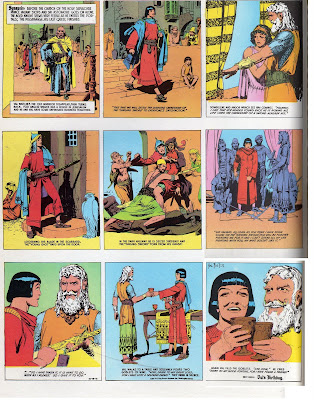
Buy Prince Valiant : Companions in Adventure (with Prince Valiant : In The Days Of King Arthur)
Thursday, March 13, 2008
1950s
During the 1950s, the superhero genre fell out of favor with comics readers. In response, several comics publishers switched to such genres as romance, science-fiction, Western and horror.
Mini-biography comic stories still got published, including the one below (from Boys' Life Magazine, Dec. 1956, p. 54).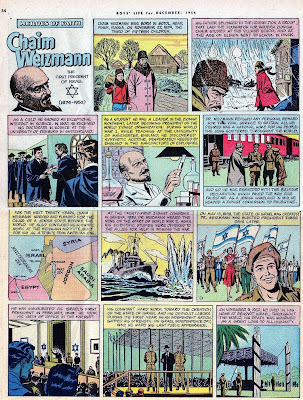
Although war stories continued to be published in American comics, most of these took place during wars that Western countries fought, usually involving the American military. An exception is "An Army Is Born", which appeared in War War #16 (Feb. 1953) and was illustrated by Paul Reinman. This story takes place during a battle at Letrun during the 1948 War of Independence. The story shows how a lack of training and poor equipment made it difficult for the volunteer soldiers who fought there. At the end of the story, Mark sacrifices himself by blowing himself up near an approaching tank. Although the closest parallel for American readers of the time would have been the Japanese kamikaze pilots of WWII, it still seems odd to see a visual of an Israeli deliberately blowing himself up (even though it occurs on a battlerfield and not on a bus or in a cafe).
Wednesday, February 13, 2008
1960s
During the 1960's, superhero comics made a comeback, partly due to their incorporation of sci-fi elements, such as time travel, aliens, and robots.
In the following Superman comic, Superman (and cub reporter Jimmy Olsen) travel back to the days of ancient Israel to help save Samson. While there, Jimmy introduces the Israelites to Beatles music. Superman's Pal Jimmy Olsen #79 (Sept. 1964).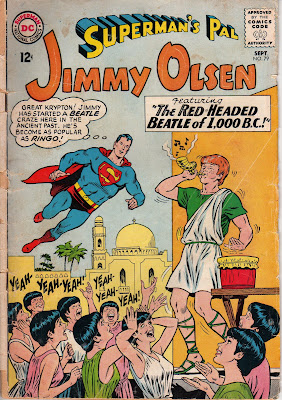
Buy Jimmy Olsen #79
One of the new series developed was Green Lantern, a comic about an intergalactic police force. When it was decided to introduce a race of identical-looking blue-skinned aliens who would oversee these Green Lanterns, someone thought it would be a great idea to model these Guradians of the Universe after Prime Minister of Israel David Ben-Gurion. Though they've never had a series of their own, the Guardians have sporadically appeared in comics published by DC right up to this year, 35 yerars after Ben-Gurion's death.
A short-lived series that debuted in the '60s was The Fightin' Five (Charlton Comics, 1964-1967 ; reprinted 1981-1982), about a multi-cultural team of spies. Among the specialists is Irv "The Nerve" Haganah (called Irv David in the story). 
Sunday, January 13, 2008
1970s
In Jan. 1973, Yaakov Kirschen's comic strip Dry Bones debuted in The Jerusalem Post. It has become one of the oldest & well-known continuously-published English-language syndicated comic strips about Jewish & Israeli life. Although the artwork is simplistic and often consists of little more than a talking-head monologue or a dialogue between two talking heads, it is the sharp wit and timely obersvations that have gained it a worldwide following. Since 2005, Kirschen has published his new cartoons on his blog in full color, in addition to selected "classic" ones. His website allows him to comment on his cartoons and he welcomes comments from visitors to his site, as well.
Buy What a Country!: Dry Bones Looks at Israel
Buy Trees: The Green Testament (also by Yaakov Kirschen)
In Italy, a series of fumetti books by Roberto Raviola (aka Magnus), Lo Sconsciuto, told the story of a fictional mercenary. The following pages, which are self-explanatory, are from book 6 - Vacanze a Zahl.
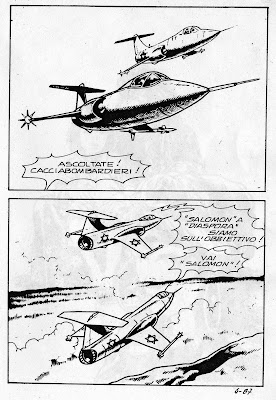




One of the superheroes introduced in the '70s by Marvel was The Living Mummy. However, the character didn't become very popular and not many stories were published. In the first few pages of the first story, The Living Mummy (a seemingly Egyptian archetype) encounters a pair of Israeli soldiers. Although it would seem like a modern version of Egyptian-Israeli conflict, that isn't the case. The mummified hero turns out to be African, the leader of an enslaved tribe, giving him a historical connection to the Jews and, thus, Israelis. Though at first, the Mummy seems ready to retaliate against the soldiers (who felt threatened by his monstrous appearance), the Mummy changes his mind after seeing the female soldier close up (Supernatural Thrillers #5, Aug. 1973).
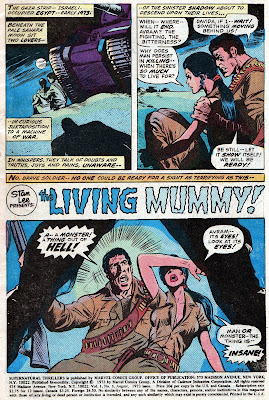
Buy Supernatural Thrillers #5
In another story ("A Choice of Lions", Supernatural Thrillers #10 Dec. 1974), the Living Mummy finds himself stepping into the middle of a one-sided battle between a female Israeli soldier and a tank. Recalling his own need to prove himself as a warrior long ago, the Mummy helps even the odds, allowing the lone Israeli soldier to blow up the tank and pass her "test".

Buy Supernatural Thrillers #10
In 1972, Israeli cartoonist Dudu Geva published a short English-language cartoon called "Super Golda" in the publication Lillit, which was reprinted via the Jewish Student Press-Service. Rather than duking it out with dangerous super-powered criminals, Super-Golda-Meir must battle ... intellectuals who criticize her government policy!
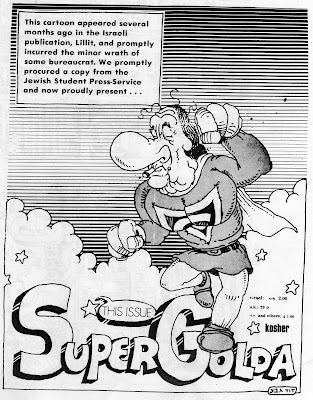

"Introducing Mind-Wave and His Think Tank!" (Daredevil #133, May 1976) guest-starred real-life Israeli celebrity (& alleged super-psychic) Uri Geller.

Buy Daredevil #133
"The Warning of the Wonder Twins" (Super Friends #7, Oct. 1977) introduced the Israeli superhero Seraph, a walking Biblical stereotype, seen here teamed up with Superman, whom he rescues from a gravity field.
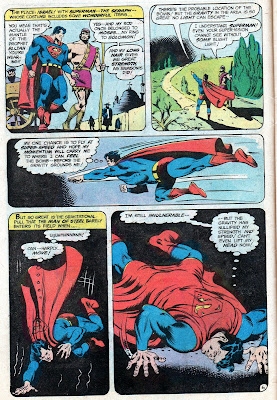
Buy Super Friends #7
The following year, 15-year old Uri Fink wrote & illustrated the short-lived Israeli superhero series Sabraman.
Thursday, January 10, 2008
1980s
During the 1980s, there were 3 stories which depicted ancient Israel.
In France, Massada : La Première Guerre Des Juifs Contre Les Romains (Dargaud, 1987) retold the story of the revolt on the mountain fortress which ended in mass suicide.

Buy Massada
Joe Kubert published a series of 2-page stories featuring Yaakov and his friend Isaac for the Lubavitch children's periodical Moshiach Times. Some of these have been reproduced online and a collection of them were published in the book The Adventures of Yaakov & Isaac (Mahrwood Press, 2004). "The Kutim" takes place during the time of Alexander the Great.
Buy The Adventures of Yaakov & Isaac
In 1981, the 26th book in the Astérix series was published - L'Odyssée d'Astérix, which was translated into English as Asterix and the Black Gold. Though credited to both Rene Goscinny (who was Jewish) and Albert Uderzo, in truth the story was written solely by Albert Uderzo, as Goscinny had already passed away. The story involves a quest to retrieve oil which is used as an ingredient in the special potion that gives Asterix and his townspeople their magical strength. The quest takes them to Israel, where Asterix and his companion Obelix befriend Joshua Ben Zedrin and Samson Alius (Rosenblumenthalovitch).
Buy Asterix and the Black Gold
A second Israeli superhero comic was attempted in 1987 - Uri-On written & illustrated by Michael Netzer (nee Nasser).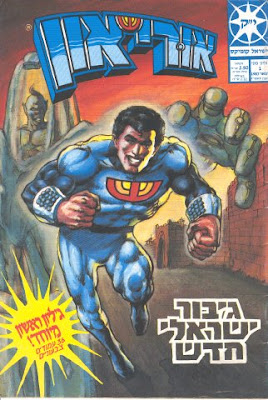
Though Shaloman lives in Israel (where he spends time as part of an Israeli mountain when he's not helping those in need), his adventures often take him elsewhere. An exception is the Shaloman story "Intifada and Israeli Commandos" (Shaloman #2, 1989).
Buy Shaloman #2
Israeli superheroes rarely have a series of their own and, when they do have them, they are usually short-lived. Most of the comics that have Israeli superhero comics are rather formulaic. The Israeli superhero(es) assist(s) the non-Israeli superhero(es) in defeating the villains (who are often Arab or Palestinian terrorists).
Two other superhero characters who were introduced during the '80s were :
Dust Devil (Blasters Special #1, 1989)
Buy Blasters Special #1
Sabra (Incredible Hulk #256 Feb. 1981)
Though Sabra could have become a positive portrayal of an Israeli woman in comics, her character is often written into stories where she ends up being a threat &/or exercises poor judgement. It's unclear whether this is just an unfortunate coincidence -or- whether this reflects how Marvel's writers feel about women, in general -or- whether this reflects how they feel about Israel & Israelis. Perhaps it's a bit of each.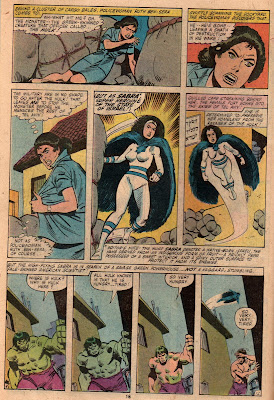
Buy The Incredible Hulk #256
The incidence and usage of Mossad agents in comics is similar to that of Israeli superheroes - they are usually simply guest characters who help foil the plans of the "evil Arabs". In several stories, the writers choose to make the agents female.
Among the Mossad agents introduced during the '80s are :
"Rose" (Punisher #7 March, 1988)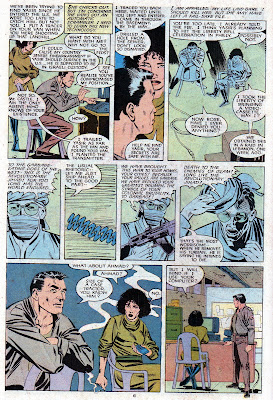
Buy Punisher #7
Rachel Elazar (Jon Sable Freelance #22-24, 1985, reprinted in The Complete Jon Sable Freelance Volume 5 (IDW, 2005) 
Buy Jon Sable Freelance #22 #23 or #24
Buy The Complete Jon Sable Freelance Volume 5
Beth Stein (Cloak and Dagger #11 March 1987)
Buy Cloak and Dagger #11
Sharmin Rosen (Batman #426 Dec. 1988)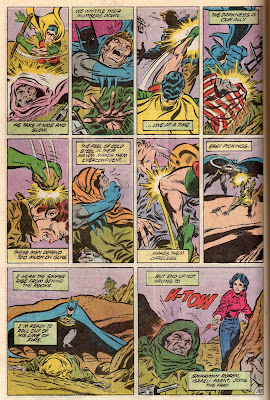
Buy Batman #426
Yousuf Tov (Super-Villain Team-Up #16 May 1979)
Buy Super-Villain Team-Up #16
an unnamed group of agents (Justice League of America #226 May 1984)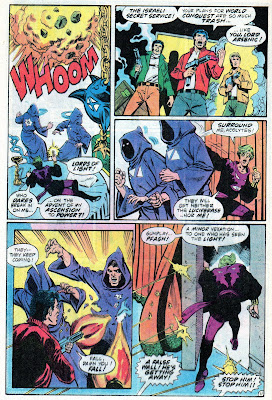
Buy Justice League of America #226
Jacob Ram (Mark Hazzard : Merc #3 Jan. 1987)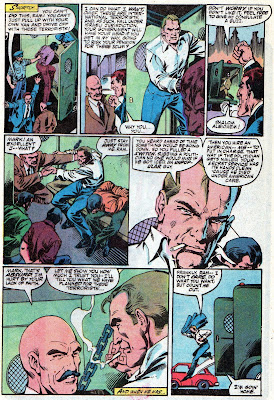
Ibrahim and a group of Sephardic agents (G.I. Joe Special Missions #2 Dec. 1986). It should be noted that depictions of black Israelis and Sephardic Jews are rare in comix.
Buy G.I. Joe Special Missions #2
In the short piece, "Casting Stones" (World War 3 Illustrated, reprinted in The Mammoth Book of Best War Comics, Carroll & Graf, 2007, p. 511-512), Eric Drooker both compares King David's slinging a rock at Goliath with the rock-throwing of Palestinian youth during the Intifadah and suggests that "King David" (Israel) has turned into a giant "Goliath" due to its greater military strength compared to the Palestinians living in the occupied territories.

Buy The Mammoth Book of Best War Comics
In 1982, an Israeli peace organization appropriated a page from an American war comic story, removed the English captions and dialogue, and replaced them with Hebrew, thus creating the 1-page story "Pilot B", incorporated into a flier advertising an upcoming event.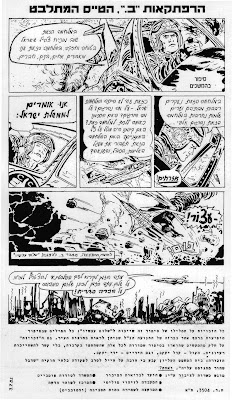
Weird War Tales #83 (Jan. 1980) included the 8-page story "Prison of the Mind", in which an Israeli soldier who is captured during the Yom Kippur War is released after being mind-controlled through surgery. The enemy Syrian soldier tries to use him for political assasination (a la Manchurian Candidate).
Buy Weird War Tales #83
In Teen Titans #24 (Oct. 1986), an Israeli commando - Israel Harel - rescues hostages on an airplane before being shot by one of the terrorists. His body is later recovered and he is transformed into the super-powered being Pteradon and recruited into a team called the Hybrid.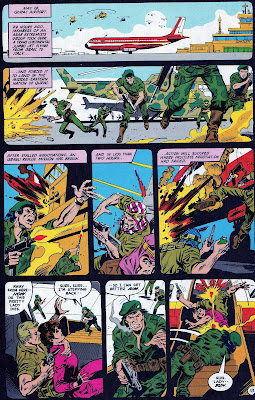
Buy The New Teen Titans #24
In Scout #12 (Oct. 1986), which takes place in the future, the Israeli military lends a hand to the American military by lending them a "Big Moishe" - a manned, heavily-armed, gigantic robot. Sergeant Rosa Winter (an American) teams up with Avner Glanzman (Israeli) to take on a charismatic cult leader who has hidden out in the mountains.
Buy Scout #12
During the 1980s, Dutch cartoonist Bernhard Holstrop (aka Willem) put together a collection of short "country studies" by creating illustrations based on photographs from newspapers and magazines and then assembling them together like a collage. The only words in these narratives are words that were in the photos themselves. "Jerusalem" was one such narrative.
Although such work may not seem original, Willem could take creative license in how he redrew any particular image, adding details, removing details, or exaggerating for effect. He made deliberate choices in which photos to recreate (& which to exclude), how many to use in total, how many pages to use, how many illustrations on a given page, the size of specific images (which varies throughout the piece) and the order of the images. Though the totality cannot be casually dismissed as totally anti-Israeli, it cannot be labelled as totally pro-Israeli either. The only clear-cut point-of-view to be found in the piece is at the top of the 3rd page, where Willem juxtaposes the logos of major oil companies.





Buy The New Comics Anthology


